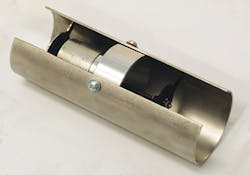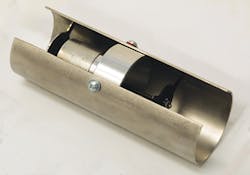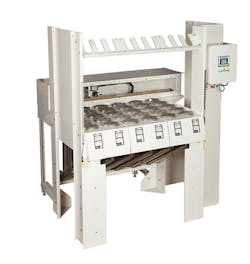Special Report: Suppliers advance methods to combat conveying issues
Plastics Machinery Magazine asked major suppliers of material handling equipment and systems about their newest conveying technologies and they described a variety of solutions to the issues that most concern their clients. Those issues include material and system damage during conveyance; contamination and scrap due to operator error; dust control; and validation of the match between the material source and process equipment in a central distribution system.
Novatec:
Manage air speed, minimize
system damage
To make clear how plastic moving through a conveying line at high speed can damage itself and the equipment, Jim Zinski, product manager of conveying and controls for Novatec Inc., Baltimore, uses a simple analogy. He says that a car hitting a guardrail at 50 mph will cause more damage than a car moving at 35 mph. Typical pick-up velocity for most plastic materials is about 35-40 mph, however, as material moves through the conveying line towards its destination, the speed can easily increase to 50 mph, or sometimes as fast as 80 mph.
Zinski says the higher speed can cause soft materials to form angel hair as they pass through elbows in the line, and it can cause abrasive materials to damage vacuum lines, particularly elbows, and also vacuum receivers. Zinski says, "Yes, there are abrasive-resistant materials that can be used in material lines and receivers, but slowing down the speed of the material is the best way to minimize these issues."
He lists several ways to manage air speed:
• Adjust the material source pick-up probe to ensure a proper mix of air and material.
• Create controlled air leaks by drilling a series of holes in the line at specific points.
• Reduce the revolutions per minute of belt-driven pumps by changing the sheave combination.
• Use a flow-control valve (FCV) in the vacuum line.
• Increase the line diameter at a specific point.
• Use variable frequency drives (VFD) to select conveying speed by station.
Zinski advises that a conveying system specialist should be consulted to determine whether speed management is the best course and which method should be used. Care must be taken to ensure that the required material pick-up speed is maintained. He points out that the first four solutions listed above cost very little.
Novatec's FCV acts like a governor on the air speed inside a vacuum line. When the system resistance drops, the FCV adds resistance back into the system, and vacuum and air speed remain steady. When system resistance is already high and airflow nears a specified target, the FCV allows the air to pass through unimpeded. FCVs are relatively inexpensive and can be installed in existing vacuum lines. In the future, Novatec plans an FCV model for use at individual receivers to balance airflow through multiple receivers pulling material simultaneously using a single large vacuum source.
See sidebar: Special consideration for flakes and powder here
Lines are typically wider when conveying over long distances. Larger lines cost more, but they increase the amount of plastic moved by up to 50 percent. Advanced conveying controls used in conjunction with VFDs offer the ability to select a conveying speed for individual stations. A pump speed setting is stored with each station's parameters and this setting communicates to a VFD installed with the pump. This system works only for direct-drive pumps and is far more costly than other methods of managing air speed.
Sending material to the wrong destination is costly
Zinski says early automatic selection products were so complicated, time-consuming and expensive — easily costing $50,000 to $100,000 — that processors passed them by. Even so, more processors' customers were demanding that level of security, and processors wanted it themselves. That spurred Novatec to take a simple, less expensive approach that still ensures the source and the destination match.
Novatec says QSM, a modular quick-selection material manifold, enables connections to be made easily between processing machines and material sources. When the QSM is equipped with Novatec's Auto ID feature, the operator enters the material source and destination on the color touch-screen programmable logic controller (PLC). The operator then inserts the destination line into the matching material source line. If it's not a match, the control won't allow material to flow and an alarm is triggered. Make the correct match and materials flow. Self-locking, lance-style couplers ensure secure connections. The QSM accommodates lines with inner diameters of 1.5 to 3 inches. Up to four modules can be connected for up to 48 connections and the system can be expanded to accommodate any number of sources and destinations.
Conair:
Tackling three key conveying issues
Doug Brewster, conveying product manager at Conair Group, Cranberry Township, Pa., says that in conventional vacuum conveying, pellets are widely dispersed and move through tubes at speeds of almost a mile a minute. Pellets rub against the sides of aluminum tubing, deforming and creating angel hair, while brittle materials like PS, acrylic and PC can create dust and fines, all of which can clog the system. Harder pellets and abrasive materials like glass-filled ABS can wear away conveying lines, leading to leaks and failures. Uncontrolled static electricity buildup on and near conveying tubes can shock operators and cause dust to accumulate in the tubes, which makes purging difficult.
Conair presented a new and quite different approach to these problems at NPE. The R-Pro system, short for ResinProtect Conveying System, is designed to reduce damage by moving material much more slowly than traditional systems, which generally run at speeds from 4,500 feet per minute to 6,000 feet per minute. By contrast, in the R-Pro system, which is patent-pending, pellets move in compact slugs of material at speeds from 230 feet per minute to 1,200 feet per minute. Testing has shown that the R-Pro can convey a high volume of material — without material or equipment damage.
Brewster says R-Pro is in beta testing at several sites. A California medical molder wants it for unloading rail cars to prevent pellet fracturing and dust accumulation that's unacceptable for clean-room molding. A molder having difficulty purging red-pigmented dust from conveying lines that also convey clear material is looking at R-Pro to speed color changes and reduce pink scrap. Another processor is running soft, heavy, mineral-filled ethylene vinyl acetate resin. It is difficult to convey under any circumstances and, at high speeds, it can quickly wear out conveying system components. Initial lab tests using the low-speed R-Pro System have shown promising results, conveying high volumes of the material without material or equipment damage.
Most components of the R-Pro system are the same as in a conventional high-speed system. Brewster says special valves and other components might increase costs by 10 or 12 percent over a conventional system, but processors can expect to save money in the end because they will no longer constantly replace filters and receivers or need special hardened elbows that can cost about $900 each. Since the R-Pro system uses standard deep-vacuum pumps, conveying tubes and material receivers, it can easily be retrofitted to an existing system.
New ways to lessen chances
for human error
Where a central material distribution system is used to move material from silos, gaylords and bins to dryers, blenders or processing machines, an operator usually must manually connect a material source to a destination and mistakes can happen that send the wrong resin to a processing destination. At best, there's downtime and scrap, but it can also create product liability. Validation, says Brewster, becomes a necessity.
Conair has developed two systems to avoid human error. The most recent is Invisible Line Proofing (ILP), which can be added to a standard resin selection station. The patent-pending system uses proprietary nonelectrical sensing technology to confirm that the proper resin source is connected to the selected destination. ILP is wireless — no proximity sensors or radio frequency ID chips — and Conair says it's relatively inexpensive, extremely fast, very dependable and easy to use. If an operator connects a material source line to an incorrect destination port, the control does not allow the vacuum pump to begin conveying material. ILP is fully compatible with Conair's FLX conveying controls with a software upgrade.
The other Conair solution is the new generation of its Material Vision Proofing (MVP) system. Conair says it's simpler and less costly than other approaches to the operator error problem. With MVP, an operator designates a source and a destination in the material handling control system, and then an animation on the 4-inch color touch screen shows the correct connection. With a connection made, the machine's camera traverses the resin selector table, positions itself between the appropriate rows of ports, confirms to the control that the correct connection is made and the control allows material to be conveyed.
New ways to move powder
resins and regrind
In general, conventional loaders use screens to separate material from conveying air, which works well with virgin pellets, but not so well with powder resins and regrind because the screens accumulate dust. Brewster says Conair's two new powder-handling units — a Powder Receiver (PR series) for central systems and a self-contained PM series with an integral vacuum motor — have both good conveying and good filtration rates.
The units operate identically: Air and material are drawn into the top of the receiver and a filter guard directs powder toward the bottom, passing through as many as three pleated polyester cartridge filters that separate air from powder. When a fill sensor signals a full receiver, a blowback system sends powerful blasts of compressed air through the filters to blow off dust and fines. Brewster says a customer in Chicago that was using large amounts of regrind replaced a conventional loader with a Conair integral-motor powder loader and found that it immediately eliminated the dust accumulation around the machine. The company ordered a new loader for every machine running regrind.
Rob Neilley, senior correspondent
Contact:
Conair Group, 724-584-5500, www.conairgroup.com
Novatec Inc., 410-789-4811, www.novatec.com
Other Special Report Materials Handling stories:


